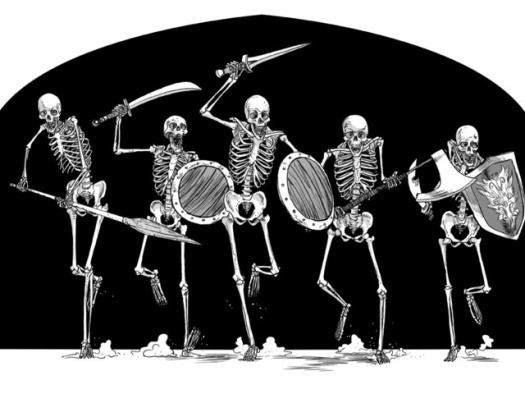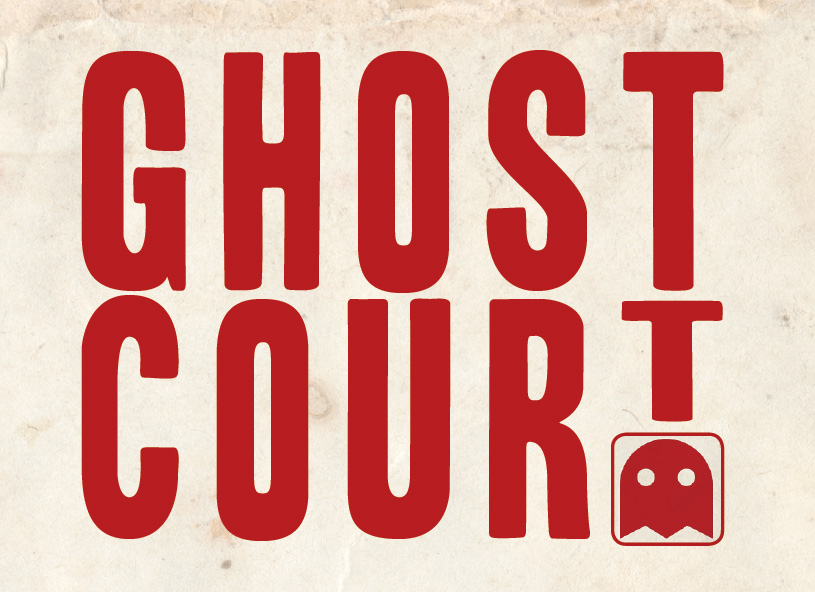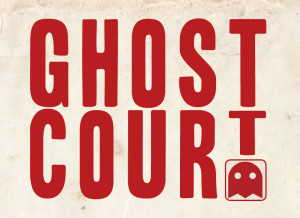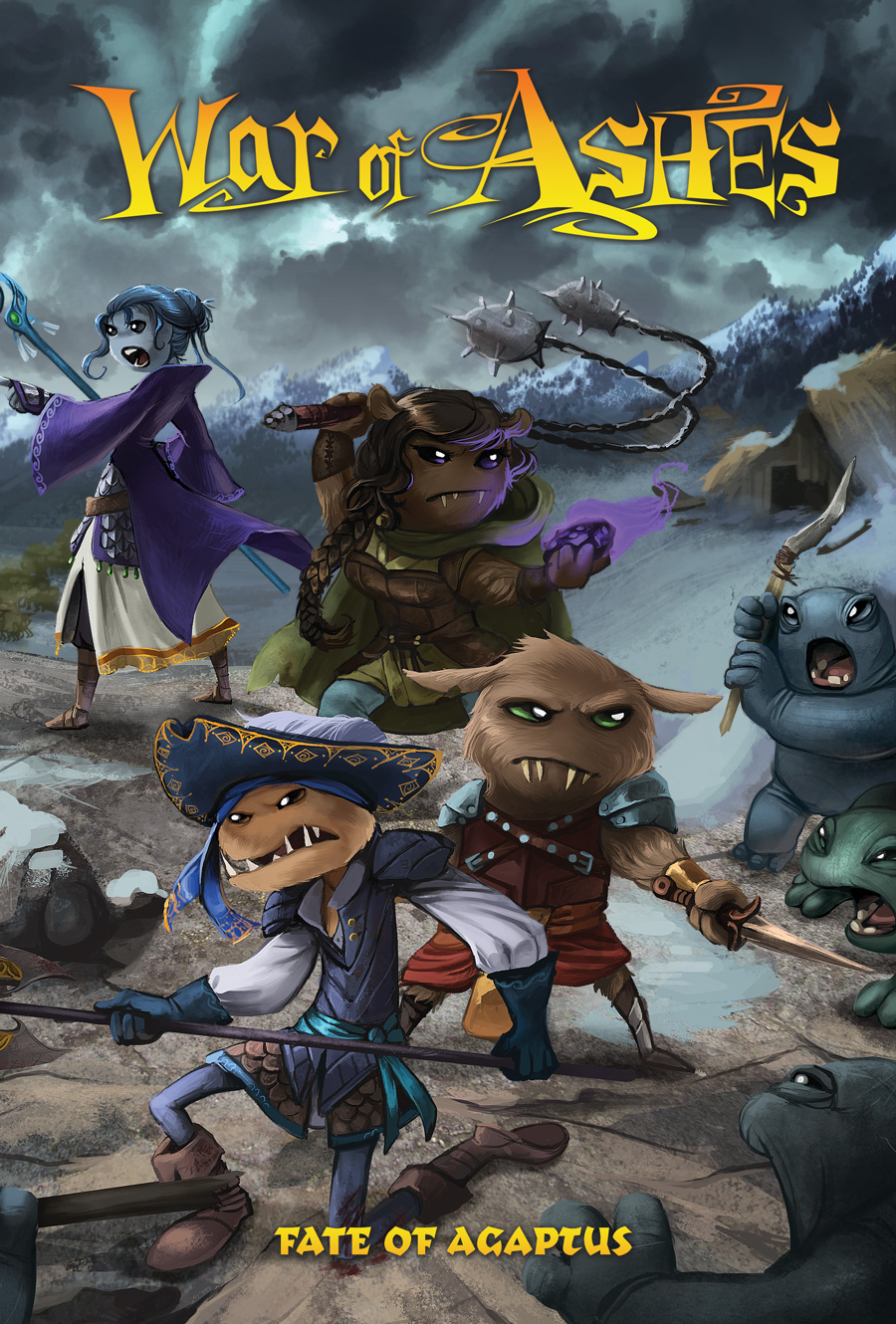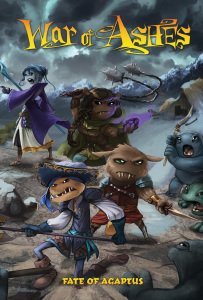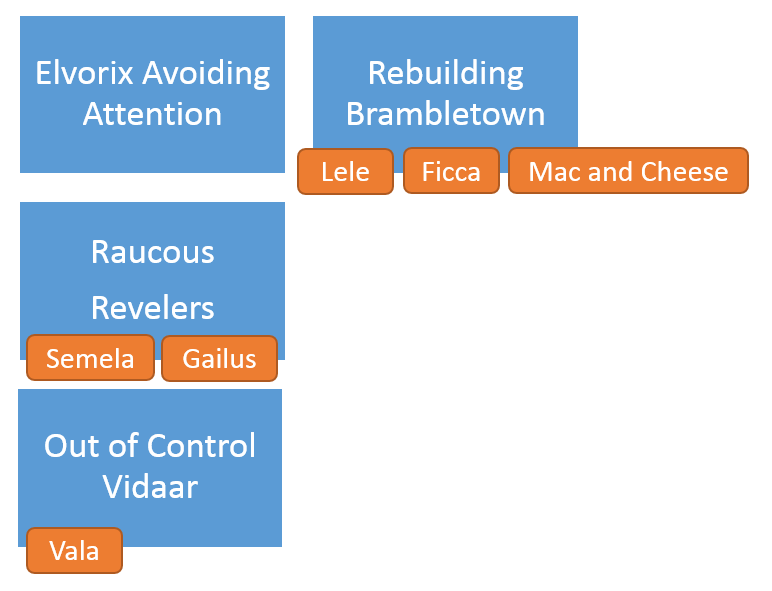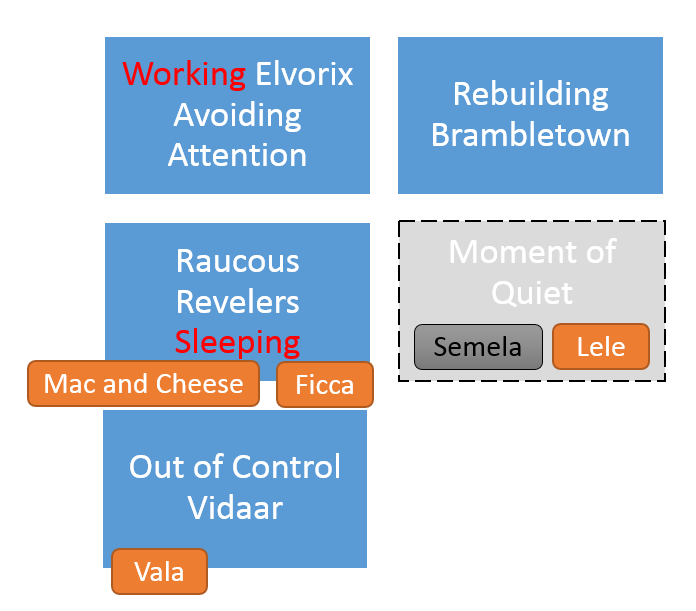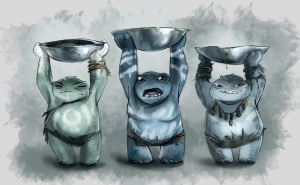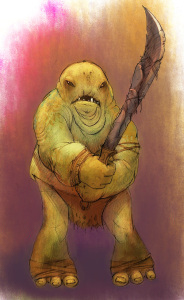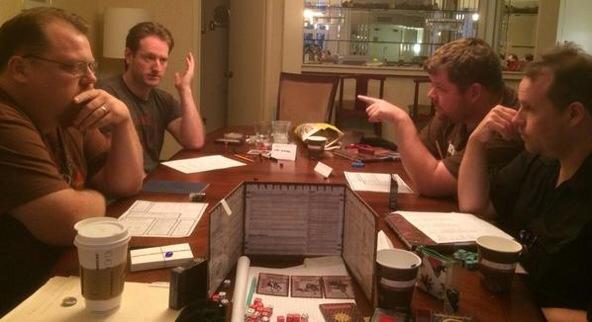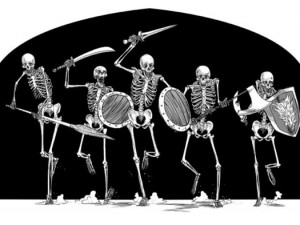 GM: Sean Nittner
GM: Sean Nittner
Players: Kristin Firth, Stras Acimovic, Shervyn von Hoerl, and Keith Stetson
System: Torchbearer (playtesting Journey rules)
Every since I got my hand on these I wanted to test the journey rules for Torchbearer. Not only because I like playtesting Torchbearer, but also because the journey rules might have direct application to Stone Dragon Mountain.
Thought the journey rules are meant to be a supplemental to existing adventures, for the sake of testing them out I made an adventure based solely on travel called The Shining Coast.
I had been pitching Torchbearer all con long but it seems fitting that on the last day, when people were all a bit exhausted themselves that brave (and foolish) adventurers would strap on their packs and set out for a trek, as we would all be making one ourselves soon enough.
Intro to the game
Shervyn and Keith were both familiar with Torchbearer but (if I recall correctly) hadn’t played much of it. Stras and Kristin had heard of it but didn’t know too much about the specifics. We were all a little frazzled and I didn’t want to spend much of our short time together going over rules, so I started off just by introducing the Beliefs, Instincts, and Goals (which we didn’t write down until after the adventure questions were answered).
In play we brought skills, abilities, traits, checks, wises, and conditions into play. This is my preferred method of teaching the mechanics, but I do worry that players get a bit short changed on the early rolls (and our first one was a Pathfinder Ob 4 roll, ouch).
We introduced inventory when that became relevant, but once that happened the game of “what can I carry” and “what do you mean I can’t wear my cloak and my backpack and my armor at the same time?” began.
Our Shining Coast (adventure set up).
What burden do you bear? What are you carrying, and why is it so important that it must arrive?
- A prisoner. What crime have they committed? What judgment will they receive?
A witch that has been possessed by a demon (perhaps the only reason she is a witch). She is to be taken to Widow’s Peak, where the demon can be exorcised and the witch can be drowned then burned. She is bound in iron and cannot use her magic, but she is still very dangerous.
What haunts your sleep? Why must you delivery be made now? And with such haste?
- Unstable parcel. What threatens the integrity of your parcel? What must you do to sustain it?
If the witch dies, the demon will be set free to possess another. She must be fed blood regularly to keep her alive. Goats are tethered to the mule drawn wagon that holds her cage, but they will not be enough. The adventurers will have to hunt or find “other ways” to sustain her.
What lies ahead? The Shining Coast is riddled with dangers, even overland. What challenge do you know will greet you?
- Natural Disasters. What terrible weather has just passed through? How has it blocked your way?
It is late Autumn and one of the fabled Shining Storms has just passed through. They sometimes roll in from the sea. Like a normal storms but filled with occasional cinders that can destroy homes and burn down fields. Reports that the North Bridge, which they must pass over or enter the Warlords Gulch, has been damaged by the storm. An inauspicious event to be sure.
Note to GM
Populate the map with details as needed. Mark locations and time to travel between them. Hand it off to the players do the same. Are there sufficient troubles ahead? If not, keep asking questions until they are!
We agreed this would be a long journey. Two weeks. Eight days out there is a small hamlet called Dosh, not much bigger than Eagle’s Crest. From there it was another six days to Widows Peak, assuming they made good timing. Also, I didn’t tell this to the players, but I decided that the path had been wash out during the storm and a short ways out of town, they would hand to either find it again, or go forging into the wild on their own.
Setting out
At first I was a bit resistant to “giving” the player a wagon, but realized it was just going to be delicious source of problems later on. So sure, why not. I called it a cart [Resources Ob 3 (already paid for), 15 inventory slots (nine of those taken by the witch’s cage), travels 15 miles a day over roads or hard, flat terrain]. Three of the remaining six free inventory slots were filled with hay to feed the goats.
Complications. I then rolled 2d6 to determine the number of complications on the first leg (8 days) journey. I got a 4 so they would only have one complication. Lucky them! I noodled a few ideas considering either the witch herself breaking free, or raiders from Warlord’s gulch, but didn’t decide (I picked raider) until a bit longer into the game when it was clear they weren’t taking their eyes off the witch and giving her some special way out when her magic was contained and she was physically bound in a cage didn’t feel like it was following the fiction. Though I certainly hinted at it a lot!
Base Fatigue. Since they were traveling in autumn, I set the base fatigue at 2. This (modified by other events and weather as they travel) would be the Ob of the Heath test they would have to make when arriving in Dosh.
Weather. I started off day one and rolled Blustery Winds! [Fatigue Ob bumped up to 3]
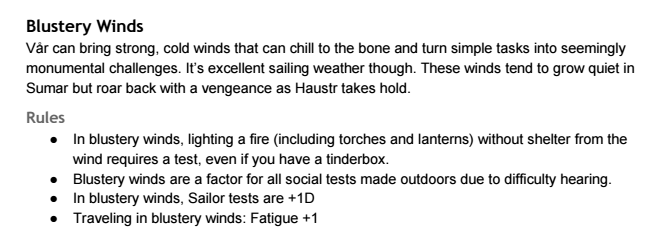
Turn by Turn
Turn 1 – Not far out of Eagle’s Crest, after it had gone inland far enough the coast could be heard but not seen the road grew fainter and fainter due to infrequent travel. After the last Shining Storm, the light tread formed by the occasional wagon wheel be came indistinct from the scrub. Soon they saw nothing but deer trails winding this way and that. [Pathfinder test Ob 4, Destination nearby (the rest of the road), ovegrown or washed out]. After some dice monger and complaining (I told them complaining about RPG rules was only a Ob 1 Peasant test if any of them wanted to beginner’s luck it), Karolina failed the test, and the whole of them were lost in the rhododendrons and other scrub brush. [Twist]
Turn 2 – Knowing the coat was basically “that way” they continued moving, convinced the would come upon a landmark that would reset their bearings. After some time they came up a fast moving creek bed, the water no deeper than a halfling. When they arrived the mule stopped, began to drink, and then just stopped, with no apparent intention of crossing. The could also tell that the creek bed was uneven enough that even if the mule got moving the cart might easily tip over. Beren, ever crafty took both his rope and Gerald’s fastened them to each side of the wagon, such that the adventurers could walk along side it holding the ropes to keep it steady [Ob 2 Carpentry, building materials, covered by Dwarven Crafting nature. Success!]
Turn 3 – Wagon secured, now they just needed to get that stubborn mule to move. The witch offered to aid in coaxing the mule to move, but nobody wanted to hear from her. Taliel, instead crossed the creek herself and from the other side began singing an enchanting elvish verse about journeys home. The mule, ensorcelled by Taliels ethereal beauty perked up and slowly made its way across the creek so that it could be closer to her presence. [Peasant OB 2, herding plus a factor for the blustery winds. Success!].
Good idea – The creek found they were able to make their way back to the coast and get back on the trail.
Turn 4 – As the day passed and night was coming close, the party worked together to find a safe camp site with protection from the elements. [Survivalist Ob 2, typical camp with “shelter” amenity. Success!]. Everyone was Hungry and Thirsty.
Instinct – Camp made Karolina and Beren set off to hunting for dinner. [Hunter Ob 2, one portion of game, forest and fields. Success!]
Instinct – Nearly alone with the witch Taliel spoke with hear to learn of her possession and how the demon could be contained if she dies. The demon spoke for itself, and told her that there was another way to contain it it. Merely give the witch as kiss on the lips and then it would pass from her to Taliel, where she could keep it safe and secure, and the witch would not longer be a danger. [Lore Master Ob 3, magical phenomenon. Success!]
Instinct – Gerald took the rabbit Karolina and Beren brought back and cooked a find supper. Someone drained the rabbits blood into a bowl and slid it into the witch’s cage. [Cooking Ob 3, game for the whole party. I can’t remember the outcome, it I think was a failure with a condition, but if you were in the game and remember, let me know].
That night, lights moving far to the west could be seen. A ship out at sea, coming closer to the coast.
The next day passed without incident, and besides the usual hunting and cooking (which I didn’t have them roll for, see below) little transpired. The did see the great ship off on the distance rising and dipping with the waves. As it go closer they saw it rise up and then descend with a great crash. The ship did not rise again.
That night torches were seen in the east moving towards them.
Turn 5 – Fearful of the raiders from Warlord’s gulch, Gerald rounded up bushes and other coverings to cover the wagon, so it could be hidden from the raiders [Scavenging. Ob and result not recorded, but it happend!]
Turn 6 – The adventurers moved away from their own camp site but left Taliel and Gerlald behind, hiding in the bushes. [Scout vs. Scout. Success!] Taliel saw the raiders sneak up on the camp, and then, when they found it unoccupied, quickly decided to make use it themselves, without to much concern about who was using it before them. The spoke of the spoils they would find on the shores and they and that they had best move fast to get there before anyone else.
Turn 7 – After the raiders were settled in and went to bed, only one guard was left on watch. Gerald led the group to quietly sneak up on him. [Scout vs. Scout test. Success!]
Turn 8 – Murdered happened [As he was unaware I made this a simple Fighter test rather than a conflict]. The guard was murdered, the throats of the rest of the raiders were slit, and what good they could take were loaded on the wagon. This was hungry and thirsty work!
Another two days passed and the weather continued to be Blustery Winds [Fatigue: 4].
Turn 9 – At night again, while Taliel medidated the demon wormed it’s way into her dreams. offering every earthly desire. Love, wealth, fame, knowledge, power, success. Anything the elf could desire. Simply wake up, kill her allies in their sleep and all the power would her hers. A desperate adventurer she might be, Taliel was not that desperate… yet [Will versus test. Success!]
On the seventh day, the wind broke and it was Clear and Cool [Fatigue: 3]

Turn 10 – The adventurers arrived at the North Bridge to find the damage was worse than they had heard. Two chains ran across the length of the bridge, with wooden boards fastened between then. Nearly in the center of the bridge the wooden boards were blasted away leaving the chains exposed and swaying in the wind. Across the way two milk farmers stood with their cow, looking at the bridge in awe and confusion. The argued about whether or not to go east to where the river could be passed but they would be close to warlord’s gulch, or just go back home. Beren meanwhile got to completely taking apart the cart. He stripped it down to individual boards, and then started using those boards to replace the shattered pieces of the bridge. It wouldn’t “repair” the bridge, but he thought he could make it passable, at least for a person. [Nature test, Success!]
Turn 11 – Tentatively prodding his work Beren was convinced it would hold a person, but it couldn’t be sure if it would hold two people struggling to carry a heavy iron cage with a witch in it. They had to go slowly to not lose their balance, but fast enough the bridge didn’t give out. Taliel had a back up plan. She was prepared to cast lightness of being. The ran spears through rungs in the cage so they could hold it at a distance and then made the difficult treck over. The whole thing took hours, and when they were done, everyone was exhausted! [Ob 6 Health text. Failure, Condition Exhausted]
Elated by their success (and the not dying). Beren collected the boards on the bridge so they could rebuild the cart and continue their very long, and very perilous journey…
What Rocked
At some point, you know just to add more gonzo to the mix, someone said the witch was a shapechanger as well. Oh good. So throughout the game I kept depicting the witch as mix of different appearances. A hulking brute barely contained in the cage, a young girl, malnourished and weak, an exceedingly handsome man with a devilish smile, a bald old woman with squinting eyes. There was no mechanical effect of this but I very much enjoyed never describing the change, but always the particular effect. “He hunches over, his shoulders pressed against the bars.” …. “She looks hungrily at your dinner, her stomach rumbling and the manacles dangling loosely on her wrists.” Yeah, I enjoyed playing that witch quite a bit.
There was some really interesting discussion about what to do with the raiders. They weren’t really interested in the adventurers, but they were a threat. And while they might have been able to sneak past them all, there was no way they would get the cart and the goats past them without notice. In fact they had to move the carter farther away than expected because the witch wouldn’t be quiet. Thanks to those blustery winds for muffling her voice! So, they thought about all of their options, and the safest thing was murdering them all in their sleep. Grim.
There were great moments where the system shined and people were like “damn” that is awesome. Getting across the creek at first wasn’t that challenging a task (two Ob 2 tests). But they way the players did it was beautiful. Kristin was like “hey, my character has rope. He can make a harness. Anyone else have rope?” Gerald did and so he and Beren set about like an A-team montage. Then when Stras asked what elvish singing was for and I read the description his eyes lit up. And when they did it everyone had this great sense of accomplishment…from crossing a creek!
What could have improved
There was some real clashing with the constraints of the system. Stras in particular brought up some things that frustrated him. I want to take the cloak and put it on. No room to put it on, okay, I put in in my backpack. It take two slots, okay, I put it in a sack. I have to hold the sack in one hand once I fill it? Okay, I roll it up and tie it to the top of my backpack. That takes a laborer test to carry additional items? Okay, I put it on the wagon. The wagon is full? I just drape it over the feed barrels. That takes a laborer test? Okay, I have an empty head slot. I wrap it up like a turban. That takes a weaver test? I burn the fucking cloak.
This happens. It’s one part player expectations (Torchbearer is a very different game than many fantasy RPGs) and it’s one part making sure to follow from the fiction. In a later discussion with Stras, I told him “I should have never said no, I just should have asked what you did to make it work and then had you make a test accordingly.” Stras pointed out that would have felt like a gotcha, which is another thing I’ve run into in other games, specifically the players feeling “tricked” into using up their resources (turns) on things they didn’t think would be tests. This is a kind of connotative dissonance that results from different expectations and I think early investment in establishing those can really help. Also, once you’ve been playing for a while, so long as everyone keeps a positive attitude and doesn’t take it too personally, you fall into a rhythm and it gets easier.
I felt it a bit redundant that I made two challenges which were essentially both “get across this thing”. I like those kind of challenges, but I think I should have filled the first river crossing with some other features to make it more distinct. Raging waters, a predator stalking them on the other side, goats getting skittish (though the mule already was), the witch momentarily regaining her power when crossing over the water. Of course all these ideas come to me now, but damn, in the moment I was like “uh, stubborn mule, top heavy wagon, Go!”
Rules clarification for myself to look up. When a’mn instinct is triggered by “camping” does it require the camp phase, or can it be done any time someone says they are settling down for the night. In our journey days passed and they hunkered down, but they stayed in the adventuring phase (at first because nobody had checks and later because they didn’t need to remove conditions or do other camp actions). I allowed it but I’m not sure that was correct. This seems particularly important for long overland journeys.
There were very few failed rolls in this game. Now, that’s hardly a problem per se, but it’s usually failed rolls leading to a twist that really get the action going. It’s also twists that reveal how the mechanics reinforce the fiction. Tried this and something else happened, now you’ve got to deal with that! Not a horrible fate for the game, but oh how I would have loved it if Beren’s roll to fix the bridge had failed…
Playtest specific feedback
In addition to the things noted above, here were my observations:
- A journey is not enough to make an adventure. If the journey is just one leg of an adventure, it’s probably adequate to do some inventory management, handle a few complications, and then make health checks at the end. For me though, I wanted to play out the trials and tribulations of getting to Widow’s Peak and so I found myself adding a lot more challenges to the mix. They were fun to play, but I was doing it all off the cuff. I missed my dungeon rooms!
- I wasn’t sure about pacing and resources. When do you play out ever step of the road and when do you say “three days pass, mark off three rations each.” This becomes especially relevant when the Halfling says “wait, wait, I’m going to cook every night so we only need three rations total”, and then the Warrior says, “wait, wait, I’m going to hunt every night, so we don’t need any rations at all.” Do you treat all of these actions as part of the adventure phase (thus potentially denying camp based instincts, see above) or do you make the do something so they can earn a check, so they can enter camp phase, so they can use these instincts. As a GM, what’s a good way to parse the conversation? Here’s a few ideas I can think of:
- Tell the players. “You need to travel for X days, so unless you want to do anything along the way, everyone mark off X rations.” Then wait to see if anyone objects.
- Ask the players “How do you want to handle this journey. Take your time and resources [Turns] to go hunting an cooking and what not, or use up supplies you have?”
- Or play out every day, one at a time, even if there isn’t an event or challenge to be had per se (this seems the slowest, but most fitting with the rules as presented).
- Hand wave it and say “Okay, it takes X days but because you hunt and cook every night, don’t worry about rations just the complications as they come up. What do you know, there’s a bugbear in your path!” This is the worst and the best option. The worst because you’re disengaging all the gears of Torchbearer. The best because as a GM, you’re electing to dive right into the bits that are exciting you. Note, feel free to replace bugbear with fire, flood, bandit, magical phenomenon, candy house, etc.
- Travel distance and time seems oddly more concrete than most aspects of Torchbearer, which are abstracted. I wouldn’t think to specify the number of miles between two locations, and then to do the math to divide that into the speed of travel. I mean it can be done, but my inclination was much more along the lines of, this will take X days. Given different rates of speed though, I can see how X days isn’t as useful. I’d consider a roll (not necessarily a test) made at the beginning of a journey, with modifiers based on the speed of travel. Walking would be flat and other modes would give penalties (if slower) or bonus (if faster). The result of the roll would be a days added or subtracted from the base. So if the base time for a trip was six days, you’d roll and see if that could be done is a day less, or a day more, etc. To be efficient, this could be attached to the complication chart (as an additional column) so the amount that a journey could be modified by would be based on how long the original journey is in days.
 Participants (in various roles): Lali Cheshire, Karen Twelves, J Li, Ezra Denney, Tom Vallejos, Colin Fahrion, Eric Zim, Brian Williams, Sophie Lagacé, Edmund Metheny, and Sean Nittner.
Participants (in various roles): Lali Cheshire, Karen Twelves, J Li, Ezra Denney, Tom Vallejos, Colin Fahrion, Eric Zim, Brian Williams, Sophie Lagacé, Edmund Metheny, and Sean Nittner.![Actual Play – Big Bad Gauntlet [Playtest] (9/27/2015)](https://seannittner.com/wp-content/uploads/2015/10/Big-Bad-Gauntlet_02.jpg)
